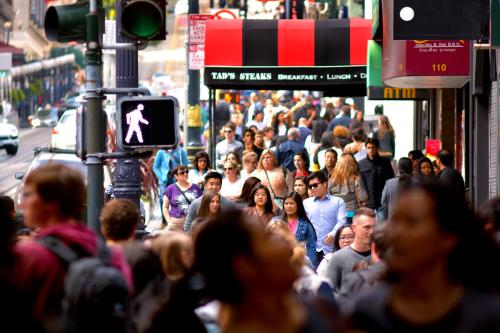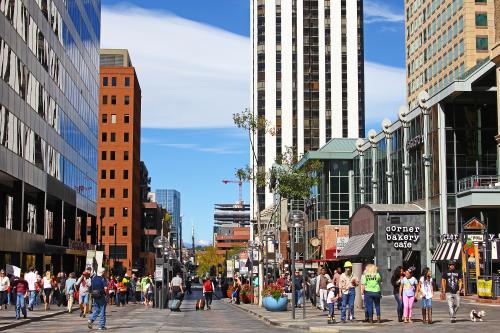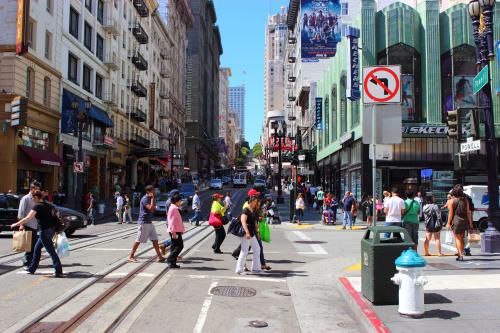Suburban growth outpaces city growth for second straight year
Newly released census data for city population growth through 2017 show that what I and others previously heralded as the “decade of the city” may be less valid during the waning years of the 2010s. While most big cities are still gaining population, the rates of that gain are falling off for many of them as the nation’s population shows signs of broad dispersal.
The new numbers for big cities—those with a population of over a quarter million—are telling. Among these 84 cities, 55 of them either grew at lower rates than the previous year or sustained population losses. This growth fall-off further exacerbates a pattern that was suggested last year. The average population growth of this group from 2016 to 2017 was 0.83 percent—down from well over 1 percent for earlier years of the decade and lower than the average annual growth rate among these cities for the 2000 to 2010 decade (see Figure 1).

While the diminution in this rate may seem small, it is sizeable in aggregate population numbers. Between July 2016 and July 2017, these large cities together gained 424,000 people, well below gains exceeding 600,000 for each of the first five years of the decade. In the most recent year, New York City’s gain of 7,300 people is dwarfed by gains exceeding 90,000 residents during the first two years of the decade.
New York’s situation is emblematic of this trend because the most pervasive growth declines are seen in the biggest of these cities (download Table 1 here). Among the 25 largest cities, 21 registered growth rates from 2016 to 2017 that were either negative or lower than the previous year; for 15 of these 25 cities, the same year’s growth rates were the lowest of the decade. Figure 2 depicts the situation for five areas with more than one million residents.

It shows declines in cities with both low growth rates (New York City, Los Angeles, and Chicago) and high growth rates (Houston and San Jose).[1] The reason for these declines may be attributable to high costs of living in some, increased attractiveness of the suburbs, or economic circumstances associated with industrial decline in an entire region.
The latter almost certainly impacted some of the 16 areas that lost population over the recent period, including Baltimore, St. Louis, Chicago, Pittsburgh, Milwaukee, Detroit, and Cleveland (see Map 1). Yet, this is the largest number of cities, among those with over a quarter-million population, to sustain losses for any year of this decade. (In 2010, the peak year for big city growth, only four cities—Buffalo, Cleveland, Detroit, and Toledo—sustained population losses.)

There are still cities where growth has shown upticks in recent years, including affordable Midwest places like Columbus, Cincinnati, and Kansas City; suburban cities like Henderson, Nev.; or those that lie on the periphery of pricey regions, such as the interior California city of Fresno. Another outlier of this trend is Atlanta, whose growth has risen precipitously.
Yet the pervasiveness of declining big city growth, which began to become evident with last year’s numbers, reflects a broader dispersal of the nation’s population—from large metropolitan areas to smaller ones, from cities to suburbs, and from the Snow Belt to the Sun Belt. These patterns are apparent with domestic migration flows and regional population shifts. They reflect the easing up of constrains toward personal and job mobility as the economy continues to revive.
Still another indicator of this dispersion is the return of the suburban growth advantage over cities—now apparent for the second year in a row, after five years of a city growth advantage, for the combined populations of the nation’s 53 largest metropolitan areas, each with populations exceeding one million (see Figure 3).

The huge attention given to the city growth revival in the early part of this decade was warranted given the long history of suburbanization in the U.S. The housing crunch and Great Recession in the previous decade (2000-2010) led to a situation in which the choices of potential suburban movers, especially young adult millennials, were constrained, and who, either by choice or necessity, fueled city growth levels, which outpaced those of the suburbs.
Now suburban growth again exceeds city growth, though at more modest levels than in the early 2000s, and, for many areas, due more to a city growth slowdown than a suburban growth pickup. It is still the case that city growth exceeds suburban growth in 17 of these 53 metropolitan areas, including Boston, Atlanta, Washington, D.C., San Francisco, and Seattle, though no longer New York (download table 2 here). Yet between 2010 and 2011, this was the case for 25 of these metros, and the trend seems to be shifting toward a renewed suburban advantage.
The broad population dispersal now underway in the nation, as evidenced in recent census releases, appears to be upending many of the demographic trends that seemed to make the 2010s look unique only a few years ago. This new census release of city data suggests that some moderation should be in order to claims that this will be the decade of the city.
[1] The numbers for Houston reflect change through July 1, 2017—before Hurricane Harvey hit the metropolitan area.
The Brookings Institution is committed to quality, independence, and impact.
We are supported by a diverse array of funders. In line with our values and policies, each Brookings publication represents the sole views of its author(s).






Commentary
Early decade big city growth continues to fall off, census shows
Tuesday, May 29, 2018